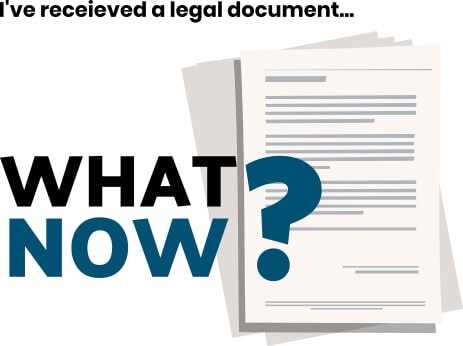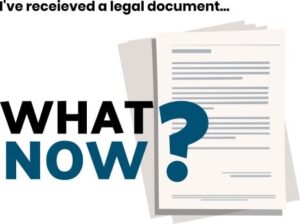If you do not arrange to be represented at the hearing, there is every likelihood that the court will order that you be declared bankrupt on that date.
It is therefore imperative that you urgently seek professional advice regarding this document
A creditor’s petition is presented in Australia under section 43 (1) of the Bankruptcy Act 1966 (the Act).
The person who owes the creditor a debt (the debtor) must have committed “an act of bankruptcy” (section 40 (1) of the Act).
Presenting a creditor’s petition, as described in the Act, means filing a Form B6 Creditor’s Petition under the Bankruptcy Rules 2016 in the Federal Circuit Court, with several prescribed affidavits to support the application. Upon filing, the court allocates a hearing date for the creditor’s petition to be heard, endorses this on the petition, and returns the documents to the creditor to be served on the debtor.
Serving a creditor’s petition on a debtor means the creditor’s petition and associated documents must be given personally to the debtor who owes the creditor money. This must be done five clear business days before the hearing, or the hearing will need to be adjourned to a later date.
Once the creditor’s petition has been served on the debtor, and at least five clear business days have passed, the creditor’s petition hearing can proceed. If the debtor does not attend the hearing, a sequestration order will be made against the debtor, effectively declaring them bankrupt (section 43 (2) of the Act).
If a sequestration order is made and the debtor is declared bankrupt, a bankruptcy trustee will be appointed by the court to administer the debtor’s financial affairs. The trustee will distribute the debtor’s divisible assets amongst their creditors. This can include part of any income they are receiving and the family home if there is equity available.
The minimum period for bankruptcy is three years. However, there is scope for this to be extended to up to eight years if the debtor is unco-operative and it is in the interests of the debtor’s creditors to do so.
After three years the debtor is automatically discharged from bankruptcy, but a record of their bankruptcy will remain permanently available to anyone searching the National Personal Insolvency Index database. This may adversely affect the debtor’s ability to obtain credit or finance in the future even after their discharge from bankruptcy.
The alternative to bankruptcy due to failing to attend a creditor’s petition hearing, is for the debtor to arrange to be represented at the hearing and to oppose the creditor’s petition. Common grounds relied on to oppose a creditor’s petition are:
- an act of bankruptcy was not committed because the bankruptcy notice was not served, or was compromised;
- the amount claimed is not owed by the debtor because it was paid, or the judgment relied on is being set aside;
- the debtor is able to pay their debts and is not insolvent;
- the debtor has arranged to pay the debt by instalments;
- there is a genuine and arguable claim against the creditor for an equivalent amount; and
- any defect in the material or procedures required to obtain a sequestration order sufficient for the court to decline to make a sequestration order.
If the debtor’s opposition to the creditor’s petition is successful, the petition may be dismissed by the court
Important considerations
Because failure to respond to a creditor’s petition served on you has such serious consequences, the creditor issuing it must have strictly complied with all legal formalities under the Act for filing and serving a creditor’s petition. Some of these considerations are set out below.
How was the creditor’s petition served?
How you received your creditor’s petition is extremely important. You should make a note of how and when you received it and keep copies of all written communications you received with it.
Are the creditor’s details correct?
Do you know the person or company who has sent you the creditor’s petition? Compare the details on the petition with previous documents you have received from them. Do they make sense or is there some confusion?
Are your details correct?
Has the person or company who sent you the creditor’s petition correctly described your details in the petition? This is very important, particularly in relation to your name.
Were you aware there was a judgment or bankruptcy notice issued against you?
The documents accompanying a creditor’s petition will include a bankruptcy notice and judgment. The judgment will have a court heading on it describing the court it was issued from, a claim number, and the parties concerned with that claim. Are you familiar with those court proceedings, or is that the first time you became aware of them? Is this the first time you saw the bankruptcy notice? If not, what were the circumstances in which you received it?
Do you owe the creditor money?
If you are not familiar with the court proceedings or judgment, check your records to see if you have ever had any contact with the person or company who issued the bankruptcy notice and creditor’s petition. Situations have arisen where the wrong person has been sued for a debt because they have a similar name to the actual debtor.
If you have dealt with the creditor before, according to your own records and understanding, did you still owe them any money? If there was a balance owing to the creditor, was there another reason you had not paid it? Did they owe you a similar or larger amount of money?
Is the amount claimed overstated?
Check your records to confirm whether the amount being claimed by the creditor in their judgment for the claim amount is the same as the balance you thought was owing. Has the creditor claimed in excess of what you thought was owing?
You may have these options
As you can see, there are many important considerations to be examined before deciding how to respond to a creditor’s petition. Investigating these considerations and gathering information to identify any errors in the creditor’s petition takes time. We therefore urge you to consider those matters as soon as possible as they will determine your options to respond to the creditor’s petition hearing.
In broad terms, your options are:
Pay the claimed amount
To pay the amount claimed in the creditor’s petition before the hearing
Settle the amount
To arrange with the creditor who issued the petition to pay off the amount claimed and adjourn the hearing while that occurs
Apply for an adjournment
To apply to the court to adjourn the hearing of the creditor’s petition
Apply for a dismissal
To apply to the court to dismiss the creditor’s petition
If the information in the creditor’s petition is completely accurate, the first two options are the appropriate ones for you to consider. If you do not currently have the financial means to pay the full amount claimed, and the creditor will not agree to an informal arrangement to settle that amount, a personal insolvency agreement under Part X of the Act is a formal option that may be available to you to achieve that outcome. Commencing this process automatically stays proceedings relating to the creditor’s petition until this option has been voted on by your creditors (section 189AAA of the Act).
It may well be that you intend to oppose the creditor’s petition on some of the grounds described above but require more time to prepare your case. You may also need more time to negotiate an outcome with the creditor or are awaiting the outcome of court proceedings related to the creditor’s debt. In those situations, you may be able to obtain an adjournment from the court. An application for an adjournment will need to be supported by affidavit evidence prepared by a lawyer experienced in bankruptcy law.
Similarly, if you intend to oppose the creditor’s petition on any of the grounds set out above, it is essential that you engage the assistance of an experienced bankruptcy lawyer to have the creditor’s petition dismissed.
One of the most persuasive grounds a debtor can use to have a creditor’s petition dismissed is to prove to the court that they are solvent. Bankruptcy is a legal process for the administration of an insolvent person’s affairs. If you are not insolvent, this needs to be demonstrated to the court. Balance sheet solvency is not enough, i.e. an excess of assets over liabilities. The test of solvency is being able to pay your debts as and when they fall due. Sufficient assets to cover those debts may not be enough to prove solvency to a court if those assets cannot be readily sold to pay creditors. To prove solvency the court needs to be shown, by affidavit evidence, all relevant material with respect to the debtor’s financial affairs so that it can make its judgment based on full facts and the actual circumstances of the bankrupt (Mehajer v Weston in his Capacity as Trustee of the Bankrupt Estate of Salim Mehajer [2019] FCA 1713).
Bankruptcy is a technical and complex area of law and you should seriously consider obtaining legal advice if you believe that there may be grounds to oppose the creditor’s petition you have received. Doing this may well be the difference between achieving a just outcome and a sequestration order being made against you declaring you bankrupt.
Important to note
If the bankruptcy notice you received prior to the creditor’s petition being presented was issued before 25 March 2020, you only had 21 days from the date you received it to apply to set it aside.
However, if the bankruptcy notice was issued from 25 March 2020, then you have six months to apply to set it aside.
If you have recently received a creditor’s petition and require assistance to urgently assess its ramifications for you, one of our expert team of solicitors will be happy to help you. Contact Gibbs Wright Litigation Lawyers today for a free and confidential initial consultation to explore your options and legal rights.




